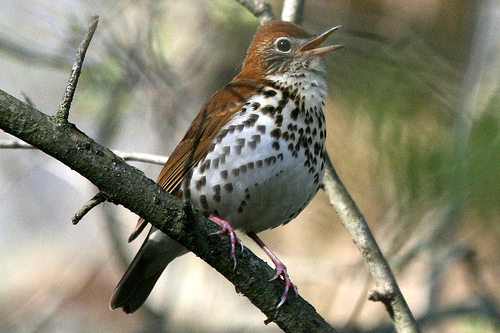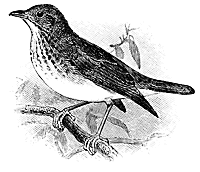|
|
Wood Thrush

(photo by BirdFreak.com)
Recorded in Penrose, NC - Late Spring, 2008 in heavily wooded area.
Recorded in Penrose, NC - May, 2010
Recorded in Columbia, South Carolina - 1982 before development moved into our semi-rural area.
Above all the birds, this one is my favorite. My heart seems to beat faster when I hear the flute-like songs of these beautiful, elusive birds. Growing up next to eight heavily wooded acres in Columbia, SC, I woke each morning to an amazing chorus of Wood Thrush songs. The 1982 recording above is dim compared to what I heard in the early 1950's. What a terrible shame that this bird is threatened! By the time 1983 rolled around, the Wood Thrushes were gone from our area even though I listened for them constantly. However, when we moved to the mountains of Western North Carolina in May of 2004, I was greeted as I walked in the door of our new house by a singing Wood Thrush in a tree by the porch. I had truly come home.
Read below for information on how this beautiful bird is threatened and what you can do to help.

VISIT MIKE NOBEL'S BEAUTIFUL SITE, WOOD THRUSH SONGS, DEVOTED TO THE WOOD THRUSH AND NATURE. MIKE'S LOVELY SONGS ARE A DELIGHTFUL WAY OF TEACHING CHILDREN THE VALUE OF PROTECTING OUR MOTHER EARTH.
One of our most beautiful songsters, the Wood Thrush breeds in the deciduous forests of eastern North America, where its flute-like melodies can be heard at dawn and dusk. This species has shown a significant decline across its breeding range since the mid-1960s, and it faces continuing degradation and destruction of its forest habitat on both its North American breeding grounds and Central American wintering grounds. Increased forest fragmentation on Wood Thrush's breeding grounds results in higher rates of nest predation and cowbird brood parasitism, thereby decreasing reproductive success.
Wood Thrush has become a species of conservation concern, and in the process, it has been established as a symbol of the decline of Neotropical songbirds in the forests of eastern North America. This species, along with many others, faces threats on both its North American breeding and Neotropical wintering grounds. Forest fragmentation in North American forests results in increased nest predation and increased cowbird parasitism for Wood Thrushes nesting in fragmented forest, thereby significantly reducing their reproductive success. The continuing destruction of primary forest in Central America eliminates preferred Wood Thrush wintering habitat, most likely forcing birds to attempt to exist in secondary habitats where mortality rates may be higher.
What Can You Do?
Audubon's Important Bird Area program is a vital tool for the conservation of
Wood Thrush as well as other species. To learn more about the Important Bird
Area programs in North Carolina, Delaware, New York and other states with
breeding populations of Wood Thrush, and how you can help, visit:
http://www.audubon.org/bird/iba/
Audubon and our partners in conservation coordinated the submission of over two
million comments to the U.S. Forest Service in support of the Roadless Area
Conservation Rule, which would protect habitat for Wood Thrush and many other
species. Unfortunately, implementation of the Rule has been stalled and attempts
are being made to weaken it.
Cornell Lab of Ornithology information on the Wood Thrush HERE